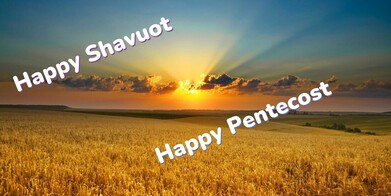
We all have our sacred symbols, scriptures, festivals, places and artefacts which are given special meaning by the stories that surround them. Good interfaith relations respects these, doesn’t judge them and appreciates them for the wisdom they contain. But sometimes it could be hard to have one’s sacred texts used and understood by those of another faith in a way that’s different from the traditional way of understanding them. To invite others into our faith perspective is in a sense to lose control over it. This is good because it could give us an added dimension but can also be difficult.
I often think this is so when it comes to Christian-Jewish relations. I think it must seem to the Jewish community that we Christians have taken over so much of what is sacred to them. We have appropriated their scriptures, interpreted them differently and called them the Old Testament. We have reinterpreted some of their festivals to give a Christian dimension to them. For example Pesach remembers the liberation of the children of Israel from the slavery of Egypt while at the same time Christians are remembering a more spiritual liberation from the slavery of sin and selfishness. Even the land of Israel, the traditional Jewish homeland, is considered a Holy Land by Christians with a concern for that country that might exceed our concern for other countries – something which is not always understood by Jews. It is a kind of Christian supercessionism which in the past went so far as the appropriate for Christians the very title of God’s chosen people. Thank God that has changed – at least in the Catholic Church which has produced a document entitled ‘God’ Call is Irrevocable’ and acknowledges the Jewish call to be God’s People is very much intact.
Next weekend both the Jewish and Christian communities celebrate festivals that are connected. The Jewish festival is Shavuot and takes place 50 days after Pesach and the Christian festival is Pentecost. It takes place 50 days after Easter. Originally a harvest festival, Shavuot focuses on the Torah and remembers the giving of the Law to Moses on Mt Sinai. Religious Jews will spend the night studying Torah, the synagogue will be decorated with flowers and there might even be a marriage canopy built around the Bimah as a symbol of the marriage between God and the People that took place when they accepted to live in a covenantal relationship with God. For Jews the Torah and the Torah Scrolls are the symbol of God’s presence among them, the most sacred object of their faith and to live according to the Torah is to keep alive God’s presence among them.
The Christian festival of Pentecost also celebrates God’s presence among His people. This time the gift is the Holy Spirit, the Spirit of God, that same Spirit which animated Jesus. It was the gift given to the disciples of Jesus after his death and resurrection. It gave them the courage to continue his mission and live according to his way. It turned fearful men and women into courageous witnesses to the life and message of Jesus. The Holy Spirit was the continuing presence of Jesus in his community, not in a physical way but in a spiritual way. And to live according to the Spirit is to keep alive God’s presence and influence in the wold today – in a sense to do for Christianity what the Torah does for Judaism.
This sense of a founder or figure in a religion being present while also absent is common. The Buddha lives on in his community and his teaching. Guru Nanak’s message is kept alive in the holy book of Sikhism, the Guru Grant Sahib, which is the living presence of God within the community. During their lives followers were inspired by their teachings and charisma but on their death believers had to learn to relate to them in a different way – a way that would allow future generations to also relate and be inspired by them. I’m sure this wasn’t easy at the time. Mary Magdalen wanted to cling to Jesus and was told she couldn’t and in a lovely Hindu story about the Lord Krishna, those who loved him when he lived in Vrindaban were heartbroken when they were told they had to relate to him in a spiritual rather than a physical way. But this is what religion is about – not clinging to the founder but living inspired by his vision and spirit which the festival of Pentecost tells us is the Spirit of God and available to all who are open to it.


 RSS Feed
RSS Feed
